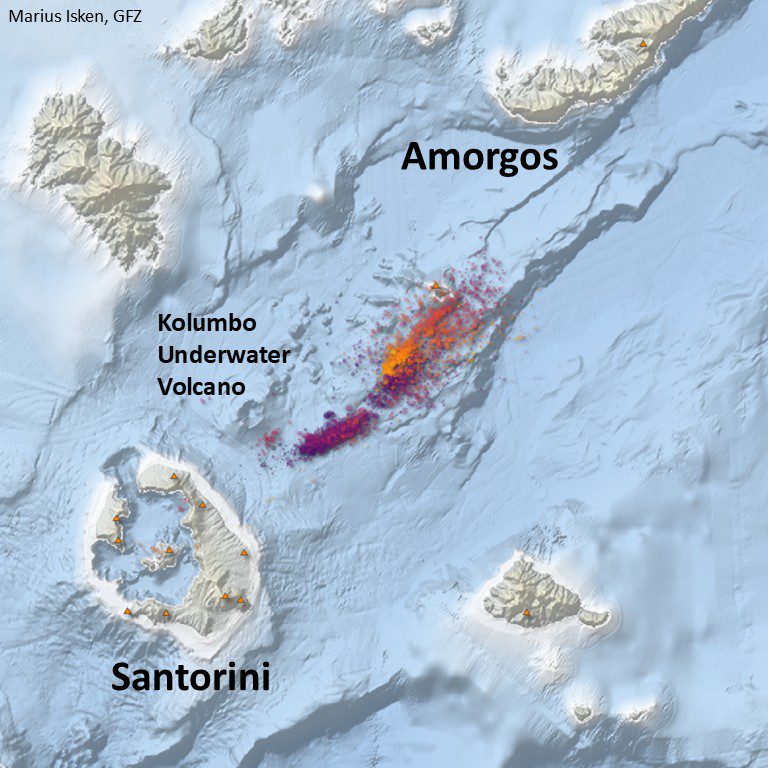
Santorini earthquake swarm leads to a state of emergency
Since late January, more than 4,000 small earthquakes have rattled the Greek island of Santorini. The epicenter of the earthquakes are in the vicinity of an underwater volcano – Kolumbo – that sits between Santorini and neighboring island Amorgos. The largest quake in the series so far was a magnitude 5.2 on February 5. Officials have cautiously placed Santorini under a state of emergency as tourists rush to leave the island. On February 6, 2025, the German Research Center for Geosciences attempted to answer the pressing question of what’s going on.
Why are these earthquakes happening?
The experts at GFZ said:
Between Santorini, the underwater volcano Kolumbo and Amorgos, many earthquakes between 4 and 10 kilometers [2.5 and 6.2 miles] deep have been occurring for more than 10 days. The magnitude of the quakes has so far reached magnitude 5 or just above. The activity started with weak quakes under Santorini and has been moving north-eastward in recent days along a crustal zone of weakness running from southwest to northeast.
Such earthquake swarms are not uncommon under active volcanic systems and have also been observed repeatedly under Santorini and Kolumbo. One possible cause is volcanic activity, as in, molten rock or other fluids rising upward in the earth’s crust. Another possibility is the movement of the earth’s plates, which can lead to stresses in the rock and the sudden release of these stresses and thus to earthquakes.
A combination is also conceivable: Individual segments of the Aegean tectonic plate in the region around Santorini move away from each other by a few millimeters. This leads to a stretching and thinning of the earth’s crust, similar to pulling a tough dough apart, which then becomes thinner in the center. Where the crust stretches, fluids and magmas can rise.
Earthquake activity offshore Santorini, Greece, imaged in high-resolution and processed by Marius Isken in our team at GFZ using github.com/pyrocko/qseek
— Thomas R. Walter (@trwalter.bsky.social) February 6, 2025 at 12:10 AM
Santorini is made from volcanoes
Santorini is part of an island group made from overlapping shield volcanoes. These volcanoes are all courtesy of the tectonic plates that meet here. So earthquakes could be due to volcanoes or they could just be due to the underlying tectonic activity. The last major eruption on Santorini was in 1950. The experts at GFZ said:
The area directly below the Santorini volcano is currently seismically calm. The last time there was similar seismic activity there was in 2011, with very shallow quakes at a depth of 1 to 2 kilometers. However, there was no eruption.
The immediate issue is that the small earthquakes could trigger landslides, so officials urge people to stay away from cliffs and beaches. Tsunamis – triggered by landslides, a volcanic eruption or a larger earthquake – are also not out of the question.
Will the Santorini earthquake swarm lead to a major quake or volcanic eruption?
The situation in Santorini currently calls for a heightened awareness. But can we know if a major earthquake or volcanic eruption is imminent? The scientists at GFZ said:
It is not possible to predict when such an earthquake swarm will occur. There are precursor phenomena, especially in volcanic earthquake swarms. We are currently investigating the temporal development and accompanying changes in the earthquake swarm, such as uplift or subsidence.
A volcanic eruption cannot be predicted either. However, unlike earthquakes, volcanic eruptions often have clear precursor phenomena. These include ground heave and swarm earthquakes, which intensify before an eruption and move towards the earth’s surface or seabed. So far, there is not enough data to warn of an imminent eruption. Nevertheless, the warnings to avoid cliffs, for example, are correct and important.
What would happen if there were an eruption or major earthquake?
The experts at GFZ said:
In July 1956, two earthquakes with magnitudes of over 7 occurred in the now seismically active region. One of them occurred in the upper earth’s crust and caused a local tsunami with wave heights of up to 22 meters [72 feet] on the island of Amorgos. The quakes caused extensive damage in the region. Fifty people died. In the current earthquake series, we are seeing much weaker quakes. The rupture zone of 1956 has not yet accumulated enough energy again due to the low displacement rates, but movements in other previously inactive rupture zones cannot be ruled out.
If an earthquake comparable to that of 1956 or a volcanic eruption (the last major eruption of the Kolumbo volcano occurred in 1650) were to occur today, stronger effects could be expected due to the denser population: strong ground shaking could damage or cause buildings to collapse, especially older buildings or those that were not constructed to be earthquake-proof. Tsunamis could hit coastal regions and lead to flooding, not only on Santorini, but also on neighboring islands and the Greek mainland. Submarine landslides of the caldera could also occur. However, the probability of this is still low.
Bottom line: The Santorini earthquake swarm has tourists rattled and thousands evacuating the island under a state of emergency. Scientists from the German Research Center for Geosciences explain what’s going on.
Read more: Can we predict earthquakes now? No, but there’s news
Read our previous article: Scientists say 2 asteroids may actually be fragments of destroyed planets from our early solar system